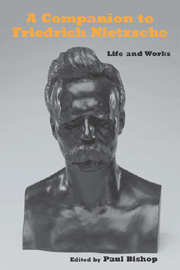Book contents
- Frontmatter
- Contents
- Acknowledgments
- A Note on Editions and Abbreviations
- Introduction
- Link to Nietzsche's Early Writings
- Link to The Birth of Tragedy
- Link to Untimely Meditations
- Link to Human, All Too Human
- Link to Daybreak
- Link to The Gay Science
- Link to Zarathustra
- Link to Beyond Good and Evil
- Link to On the Genealogy of Morals
- Link to The Case of Wagner and Nietzsche contra Wagner
- Link to Twilight of the Idols, The Anti-Christ, and Ecce Homo
- Link to the Nachlass
- Conclusion
- Notes on the Contributors
- Index
Link to The Case of Wagner and Nietzsche contra Wagner
Published online by Cambridge University Press: 05 February 2013
- Frontmatter
- Contents
- Acknowledgments
- A Note on Editions and Abbreviations
- Introduction
- Link to Nietzsche's Early Writings
- Link to The Birth of Tragedy
- Link to Untimely Meditations
- Link to Human, All Too Human
- Link to Daybreak
- Link to The Gay Science
- Link to Zarathustra
- Link to Beyond Good and Evil
- Link to On the Genealogy of Morals
- Link to The Case of Wagner and Nietzsche contra Wagner
- Link to Twilight of the Idols, The Anti-Christ, and Ecce Homo
- Link to the Nachlass
- Conclusion
- Notes on the Contributors
- Index
Summary
While he and Heinrich Köselitz were still correcting the proofs of On the Genealogy of Morals (Zur Genealogie der Moral), Nietzsche told Meta von Salis that the work indicated everything essential that should be known about him: from the preface to The Birth of Tragedy (Die Geburt der Tragödie) to the preface of his latest work there was revealed, he said, “a kind of ‘evolution’” (eine Art “Entwicklungsgeschichte”; KSB 8, 151). Before Nietzsche returned to Nice for his fifth winter, E. W. Fritzsch published a composition by Nietzsche, his setting of Lou von Salomé's “Hymn to Life” (Hymnus an das Leben), arranged for choir and orchestra. Amid the evolutionary unfolding of Nietzsche's thought, one thing remained constant: his passion for music.
After all, his first book examined the birth of tragedy out of the spirit of music, where he associated music with the Dionysian (BT §1; KSA 1, 25 and 29–30). In his fourth and final Untimely Meditation (Unzeitgemäße Betrachtung), he described “the primally-determined nature through which music speaks to the world of appearance” (die ur-bestimmte Natur, durch welche die Musik zur Welt der Erscheinung spricht), as “the most mysterious thing under the sun, an abyss in which power and goodness dwell together, a bridge between the Self and the Non-Self” (das räthselvollste Ding unter der Sonne, ein Abgrund, in welchem Kraft und Güte gepaart ruhen, eine Brücke zwischen Selbst und Nicht-Selbst; UM IV §6; KSA 1, 465).
- Type
- Chapter
- Information
- A Companion to Friedrich NietzscheLife and Works, pp. 279 - 284Publisher: Boydell & BrewerPrint publication year: 2012



